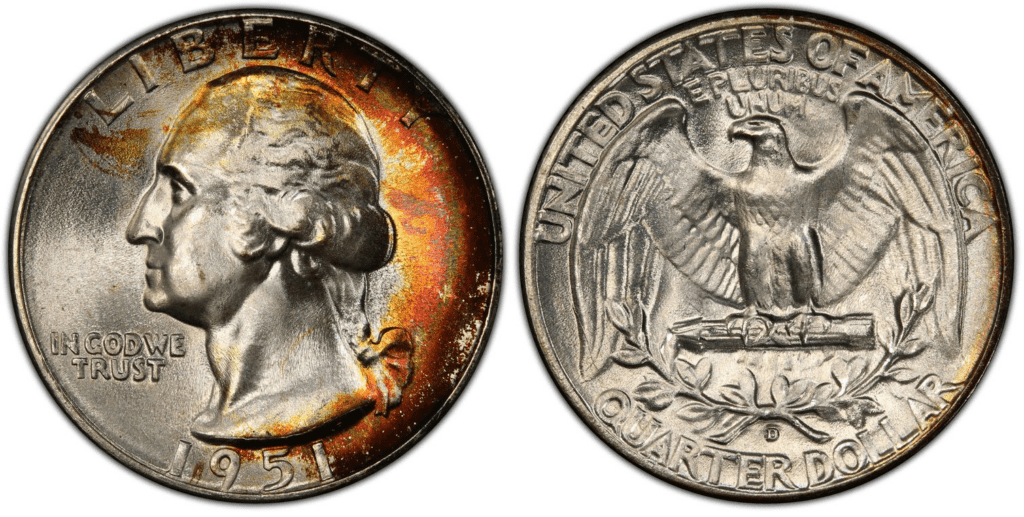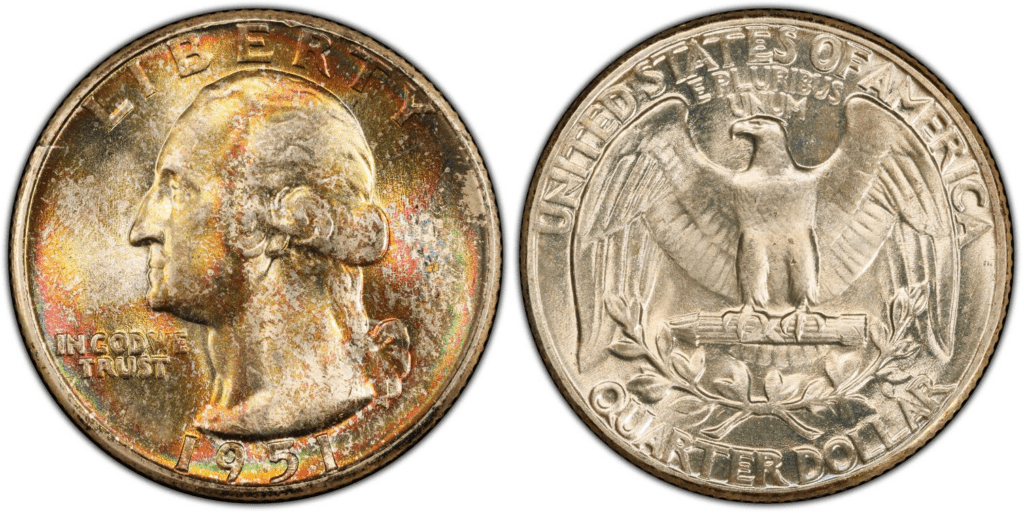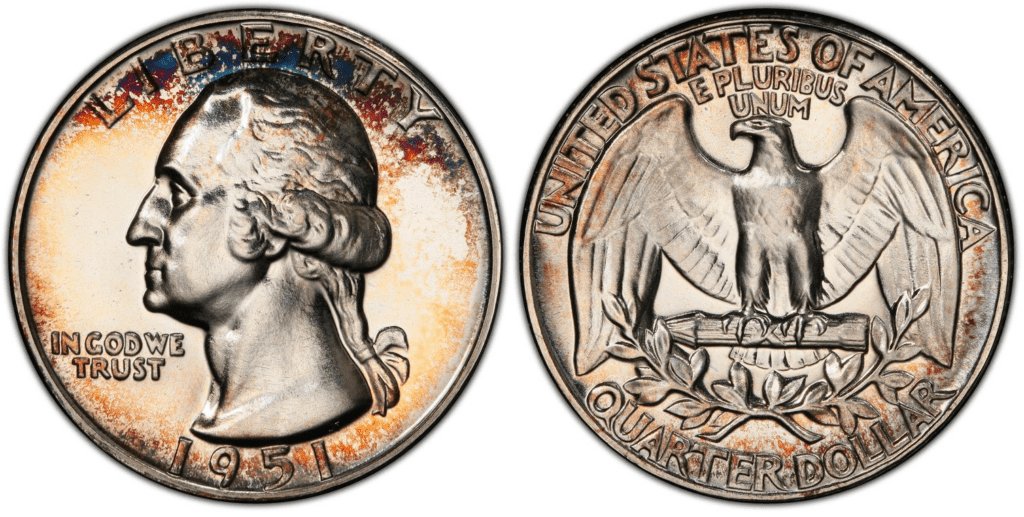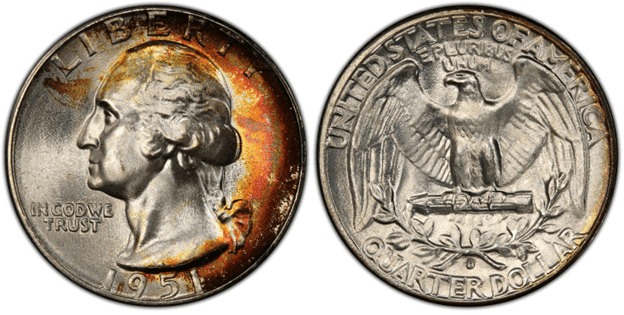The 1951 quarter, also known as the Washington quarter, was issued by the US Mint starting in 1932. The quarter was made with 90% silver and 10% copper at that time. This lasted until 1964, when the US Mint transitioned to using base metals in US coins.
The 1951 Washington quarter has the following specifications:
- Value – 25 cents
- Mass – 6.30 grams, which is slightly heavier than the quarter coins today
- Diameter – 30 millimeters
- Edge – reeded
Regarding design, the obverse side of the coin features the portrait of George Washington, the first president of the United States and a Founding Father of the beloved country.

photo source: USA Coin Book
The inscription on the obverse includes the following:
- Liberty
- In God We Trust
- 1951
On the reverse side, you will see the heraldic eagle with its wings outspread. The eagle is the symbol of the US’ strength and independence. The bird holds a bundle of arrows in its talons, which signifies the United States’s readiness to defend itself.
Below the arrows, you’ll find an olive branch representing peace. Inscriptions include the following:
- United States of America
- Quarter Dollar
Long before 1932, preparation had already begun to have Washington in one of the coins of the United States. The year 1932 is perfect because it also marks the 200th birth anniversary of the first president. Thus, the George Washington Bicentennial Committee was formed in February 1930.
As for the design, John Flagan is credited with preparing the original version of the Washington quarter. He was chosen after winning the competition held by the US Mint.
Initially, the US Mint planned to have Washington on the fifty-cent coin. However, decisions were made to have him in the 25-cent instead. Also, the design was initially intended to be used only in 1932, but later, the Washington quarter permanently replaced the Standing Liberty quarter.
1951 Washington Quarter Varieties
In 1951, the US Mint produced more than 87 million Washington quarters through its Philadelphia, San Francisco, and Denver Mint Centers. The Philadelphia Mint produced the most number of Washington quarters. The Philadelphia Mint also produced both standard-struck and proof-struck coins.
For the 1951 Washington quarter, there were four varieties produced. These are the 1951 D, 1951 P with no mint mark, 1951-S, and the 1951 P proof Washington Quarter.
Here’s a quick breakdown of the mintage figures for the 1951 Washington quarter:
| Mint Center | Type | Mintage |
| Denver | Regular strike | 35,354,800 |
| Philadelphia | Regular strike | 43,448,102 |
| Philadelphia | Proof strike | 57,500 |
| San Francisco | Regular strike | 9,048,000 |
| Total | 87,908,402 |
Aside from that, some coins with errors also created a new variety. Here are the 1951 Washington Quarter varieties that you should know.
1951 D Washington Quarter
Edge: Reeded
Mint Mark: D
Place of minting: Denver
Year of minting: 1951
Face Value: $0.25 (twenty-five cent)
Price: $0.25 to $29 (or more)
Quantity produced: 35,354,800
Designer: John Flanagan
Composition: 90% silver and 10% copper
Mass: 6.30 grams
Diameter: 24.3 millimeters
Thickness: 1.75 millimeters

photo source: PCGS
The 1951 D Washington quarter was struck in the Denver Mint. All 1951 quarters struck in Denver bear the D mint mark. The Denver Mint produced the second-highest number of 1951 D quarters, with a mintage of 35,354,800. If you trace the mintage figures of the Washington D quarter, you’ll see that from 1946, the figure continuously increased.
Although the Denver Mint produced millions of 1951 quarter coins, the 1951-D in MS66 grade and above is considered the most difficult variety to find today.
Price may range from $0.25 to $29. 1951-D in the uncirculated condition is almost always more expensive.
1951 P Washington Quarter
Edge: Reeded
Mint Mark: No mint mark
Place of minting: Philadelphia
Year of minting: 1951
Face Value: $0.25 (twenty-five cent)
Price: $0.25 to $20 (or more)
Quantity produced: 43,448,102
Designer: John Flanagan
Composition: 90% silver and 10% copper
Mass: 6.30 grams
Diameter: 24.3 millimeters
Thickness: 1.75 millimeters

photo source: PCGS
The 1951-P quarter coin was made in the Philadelphia Mint. At the end of 1951, 43,448,102 P Washington quarter coins were produced. The Philadelphia Mint produced the most number of Washington quarters in 1951. However, this won’t be the case in the following years as the Denver Mint would eventually outdo other Mint centers in terms of mintage.
It’s pretty interesting to note that among the 1951 quarter varieties, the 1951-P quarter variety is easiest to find in Gem condition. Price may range from $0.25 to $20.
1951 P Proof Washington Quarter
Edge: Reeded
Mint Mark: No mint mark
Place of minting: Philadelphia
Year of minting: 1951
Face Value: $0.25 (twenty-five cent)
Price: $25 to $50 (or more)
Quantity produced: 57,500
Designer: John Flanagan
Composition: 90% silver and 10% copper
Mass: 6.30 grams
Diameter: 24.3 millimeters
Thickness: 1.75 millimeters

photo source: PCGS
In 1951, only 57,500 proof quarter coins were made by the Philadelphia mint. This made the variety the second lowest mintage for proof coins dating from 1950 to 1964. During this time, there was a low demand for proof coins.
Proof of 1951 quarters with a grade of PR67 should be readily available. However, proof coins with cameo and deep cameo ratings are considered scarce. Price may range from $25 to $50.
1951 S Washington Quarter
Edge: Reeded
Mint Mark: S
Place of minting: San Francisco
Year of minting: 1951
Face Value: $0.25 (twenty-five cent)
Price: $0.25 to $28 (or more)
Quantity produced: 9,048,000
Designer: John Flanagan
Composition: 90% silver and 10% copper
Mass: 6.30 grams
Diameter: 24.3 millimeters
Thickness: 1.75 millimeters

photo source: PCGS
The 1951 S Washington quarter was struck in the San Francisco Mint. All 1951 quarters struck in Denver bear the S mint mark. The San Francisco Mint produced 9,048,000 1951 quarter coins, which is relatively low compared to the mintage of the 1950 and 1952 series.
Price may range from $0.25 to $28. 1951-S is quite common. You can easily find them up to MS67. Nevertheless, most 1951-S quarters today look soft and blurry due to the heavy die erosion during the minting process.
List of 1951 Washington Quarter Errors
There were over 87.9 million Washington quarters produced in 1951. As you can imagine, producing coins with this mintage could allow error coins to appear. That’s why you will find some 1951 Washington quarters with errors.
Perhaps, the most common coin error for this series is the doubled die obverse (DDO). This error happens when the die strikes the coin’s obverse side twice. Because of that, the coin would have doubling effects on the engraved elements.
DDO errors are not always obvious. However, the more prominent doubling is, the higher the coin’s value.
Another common error for the 1951 Washington quarter would be the RPM or repunched mintmark. The mint mark is supposed only to be struck once. In RPM error, the mint mark was struck twice, leaving the mint mark deformed or doubled. RPM errors were commonly seen in the 1951-D variety.
How Much Is The 1951 Washington Quarter Worth Today?
The 1951 Washington quarter has a face value of 25 cents. Its melt value is higher since it is made of silver. At the time of this writing, the melt value of the 1951 quarter is around $4.3765. This figure can change depending on the market value of silver.
Looking at face value and melt value, you might think this coin isn’t worth the money. Yet, you will be surprised to see that many 1951 quarters were sold for hundreds and thousands of dollars.
Here’s a 1951 Washington Quarter values chart for you to get an idea of its pricing:
| Coin | Condition | Grade | Mintage | Value |
| 1951 D Washington Quarter | Circulated/mint | Not graded | 35,354,800 | $4.85 to $7.25 |
| 1951 D Washington Quarter | Uncirculated/mint | MS-66 | 35,354,800 | $25 to $510 |
| 1951 D Washington Quarter | Uncirculated/mint | MS-67 | 35,354,800 | $168 to $1,140 |
| 1951 D Washington Quarter | Uncirculated/mint | MS-68 | 35,354,800 | $2,880 to $17,750 |
| 1951 P Washington Quarter | Circulated/mint | Not graded | 43,448,102 | $4.85 to $7.25 |
| 1951 P Washington Quarter | Uncirculated/mint | MS-66 | 43,448,102 | $20 to $90 |
| 1951 P Washington Quarter | Uncirculated/mint | MS-67 | 43,448,102 | $104 to $660 |
| 1951 P Washington Quarter | Uncirculated/mint | MS-68 | 43,448,102 | $2,530 to $3,738 |
| 1951 P Proof Washington Quarter | Uncirculated/mint | Not graded | 57,500 | $25 to $50 |
| 1951 P Proof Washington Quarter | Uncirculated/mint | PR-67 | 57,500 | $69 to $111 |
| 1951 P Proof Washington Quarter | Uncirculated/mint | PR-68 | 57,500 | $176 to $258 |
| 1951 P Proof Washington Quarter | Uncirculated/mint | PR-69 | 57,500 | $236 to $389 |
| 1951 P Proof Washington Quarter | Cameo | PR-68 | 57,500 | $1,140 to $2,640 |
| 1951 P Proof Washington Quarter | Deep Cameo | PR-69 | 57,500 | $3,738 |
| 1951 S Washington Quarter | Circulated/mint | Not graded | 9,048,000 | $4.85 to $7.25 |
| 1951 S Washington Quarter | Uncirculated/mint | MS-66 | 9,048,000 | $45 to $80 |
| 1951 S Washington Quarter | Uncirculated/mint | MS-67 | 9,048,000 | $105 to $149 |
| 1951 S Washington Quarter | Uncirculated/mint | MS-68 | 9,048,000 | $2,160 to $9,600 |
As you can see, the 1951 quarter can be valuable when it is still in good condition and features rare attributes.
To understand how expensive this coin can be, check out these auction records for each of the varieties:
- $17,750 – a 1951-D 25C (Regular Strike) coin with a grade of MS68 sold on 03-22-2020 by David Lawrence RC
- $14,950 – a 1951-S 25C (Regular Strike) coin • MS68 sold in 07-17-2022 by eBay
- $4,700 – a 1951 25C (Regular Strike) coin with a grade of MS67 sold on 09-20-2015 by Heritage Auctions
- $3,738 – a 1951 25C, DCAM (Proof) coin with a grade of PR66 DCAM sold in 08-04-2012 by Stack’s Bowers
How Does The Grading System Work?
The Sheldon Scale is used by numismatists to provide a numerical value to coins. The Sheldon Scale goes from poor (P-1) to perfect mint state (P-1) (MS-70). Coins were originally evaluated using words to reflect their condition (Good, Fair, Excellent, Etc.). Unfortunately, coin collectors and dealers had different ideas about what each of these terms represent.
Professional numismatists joined together in the 1970s and established CoinGrading standards. These numismatists now assign grades at key places on the seventy-point scale, using the most regularly utilized numeric points in conjunction with the original adjective grade. The following are the most common coin grades:
-
-
- (P-1) Poor – Indistinguishable and probably damaged; if used, must have a date and mintmark; otherwise, rather battered.
- (FR-2) Fair – Nearly smooth, but without the damage that a coin graded Poor often possesses. The coin must have enough detail to be identified.
- (G-4) Fair – Inscriptions have merged into the rims in some areas, and important elements have been mostly erased.
- (VG-8) Very Good- A little weathered, but all of the primary design elements are visible, albeit faintly. There is little if any, central detail left.
- (F-12) Good – The item is very worn, yet the wear is even, and the overall design details stand out clearly. Rims are almost completely isolated from the field.
- (VF-20) Very Fine – Moderately weathered, with some finer features still visible. The motto or all letters of LIBERTY are readable. Both sides of the coin have entire rims that are separated from the field.
- (EF-40) Extremely Fine – Gently used; all gadgets are visible, and the most important ones are bold. The finer details are bold and clear, however, light wear may be seen.
- (AU-50) Uncirculated – Slight evidence of wear on the coin’s design’s high points; may have contact marks; eye appeal should be adequate.
- (AU-58) Uncirculated Choice – Slight traces of wear, no severe contact marks, almost full mint shine, and great eye appeal.
- (MS-60) Mint State Basal – Strictly uncirculated; no indication of wear on the coin’s highest points, but an unsightly coin with reduced luster, visible contact marks, hairlines, and other flaws.
- (MS-63) Mint State Acceptable – Uncirculated, but with contact scratches and nicks, little reduced shine, but otherwise appealing appearance. The strike is weak to average.
- (MS-65) Mint State Choice – Uncirculated with great mint shine, very little contact blemishes, and exceptional eye appeal. The strike is unusually severe.
- (MS-68) Mint State Premium Quality – Uncirculated with superb luster, no obvious contact marks to the naked eye, and exceptional eye appeal. The strike is quick and appealing.
- (MS-69) Almost Perfect Mint State – Uncirculated with perfect brilliance, a sharp and appealing strike, and extremely good eye appeal. A near-perfect coin with minor imperfections in the planchet, strike, and contact markings (seen only under 8x magnification).
- (MS-70) Mint State Perfect – Under 8x magnification, there are no tiny imperfections discernible; the strike is crisp, and the coin is perfectly centered on a beautiful planchet. Rarely seen on a coin, this coin is bright and whole, with original luster and exceptional eye appeal.
-
Where To Buy Or Sell 1951 Washington Quarter?
The 1951 Washington quarter is available on websites such as Amazon, Etsy, and, most especially, eBay. In addition, some websites specialize in selling and buying 1951 quarters. These include JM Bullion, USA Coin Tracker, and Grey Sheets, to name a few.
Aside from online, you can visit auction houses. Some of the rarest and most expensive coins are found in auctions. Aside from that, you can go to coin shops, antique stores, and pawnshops.
FAQs
Is a 1951 quarter made out of silver?
The 1951 quarter is made out of 90% silver with an Actual Silver Weight (ASW) of 0.1808 oz.
How much is a 1951 quarter worth circulated?
A circulated 1951 quarter coin is worth between $4.85 and $7.25. However, it can be higher if the coin has rare attributes or even peculiar errors.
What makes a 1951 quarter valuable?
The 1961 quarter becomes valuable if it is still in great condition. Its strike quality is evident. The luster and color are vivid. The overall preservation level is superb. The value of a 1951 quarter is established once it is professionally assessed and graded.





